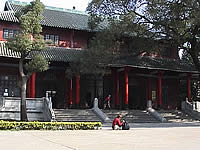|
|

|
Training
Method
At one end, the training is through constant practise
of the Forms and at the other end is through simulated
free fight or Sparring. In Wing Chun there is a
unique training which is intermediate between Forms and
Sparring which is called Chee Sau or Sticking Hands.
Chee Sau is a partnered training where the students put
into practice what they have learnt from their academic
learning of the Form. These learning take into account of
techniques, positioning around his opponent, use of energy
and to honing the sensitivity of their hands and arms to
remove their reliance on visual contact and so enhance their tactile
feeling.
|
|
Sparring
and Combat Techniques
No learning
of fighting is complete without experiencing the sensation
of a fight. One has to have sharp reaction, ability to control
ones adrenalin, ensure the limbs move the way the brain orders
and the moves are accurate to achieve the intended objectives.
Students are first taught set combat drills and then progress
to hitting focus mits and kick shields and punch bags to gain
the sensation of contact with a target and stepping forward
to judge
the correct distance. Then the students face each
other and react to the oncoming attacks and respond by
counter-attacking the opponent. He would learn strategy,
conservation of energy, use of the best techniques for the
particular situation and timing and distance.
|
|
Forms
Forms in
Chinese kung fu are fixed moves performed in a set
and repeated time and time again. Wing Chun has three Hand
Forms or Kuen Thoe: 1st Form is Siu Lim Tau
(Little Idea Form); 2nd Form is Chum Kiu (Seeking
the Bridge Form)and the 3rd Form is Bil Jee
(Trusting Finger Form). There is a 4th Hand Form which
is called Muk Yun Jong (Wooden Dummy Form). The training
of the Muk Yun Jong is unique in Wing Chun where the best of the hand techniques,
kicking techniques and body positioning are taught using a
wooden dummy built from a section of tree trunk with three
representative hands and one leg. There are two Weapon
Forms: Bart Jarm Doe Form (Eight Cutting Knife Form)
which trains on the use of a pair of cutlasses and the Luk
Dim Boon Kwun Form (Six and a Half Point Pole Form) which
trains on a straight long pole of 8 1/2 feet long .
It is no accident that there are so few forms in Wing Chun.
It was the intention of the Wing Chun ancestors to make Wing
Chun the most effective fighting system and have deliberately
removed any techniques that are flamboyant and ineffective.
The objective has always been the less the better as long
as they are effective. Simplicity also means that the full
system can be taught in the shorter time.
|
|
Weapons
There are only two weapons in the Wing Chun system. The Bart
Jarm Doe or Eight Cutting Knives are a pair of
cutlasses with 40cm blades. The application of the Bart Jarm
Doe is quite unique in the kung fu circle in that the knives
follow the principles and techniques of the hand moves. Applying
such principles as simultaneous blocks and strikes make the
Wing Chun knives very aggressive. The other weapon is the pole
called Luk Dim Boon Kwun which is 8 1/2 feet long with
a taper at one end. The pole form was acquired by the ancestors
a long time ago with a Siu Lum (Shaolin) origin. It was
adopted into the Wing Chun system. Hence the style and
principles, like the use of low horse stance, is not
characteristic in
the Wing Chun flavour.
|
|
Chee
Sau
Wing Chun is a close quarter fighting system. It requires
special techniques and special approach to fight close up.
The famous Chee Sau practice is a partnered training which simulates a
fight at close quarter. All the techniques utilised in the
blocks and strikes are academically correct in accordance
with the lessons learned from the Forms (no wild swings).
One starts with Darn Chee
Sau (Single Hand Chee Sau)having one hand making contact with one hand
of the partner's and learning the
blocks and strikes against each other. Then one progresses
to using two hands against the partner's two hands. This training
is called Seung Chee Sau (Double Hand Chee Sau). Double
Hand Chee Sau teaches simultaneous blocks and strikes using
the two hands together. It is this skill of being capable
of doing two opposing techniques at the same time that gives
Wing Chun the reputation of being fast and efficient. The
aim of learning Chee Sau is to acquire sensitivity in the
hands, know the correct use of energy, positioning the body
in relation to the partner and learn as many techniques for
the blocks and strikes needed in combat. It is this training
that gives Wing Chun students the reputation of being able
to fight blind-folded or fight in a dark room. |
|
|
|